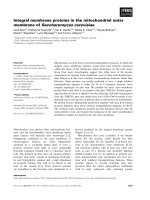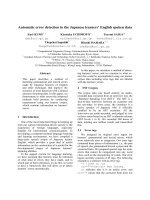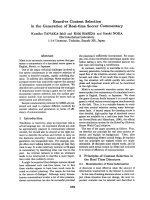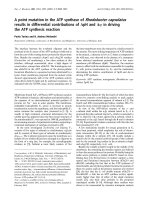Báo cáo khoa học: "Question Answering System in the Web using the Web" doc
Bạn đang xem bản rút gọn của tài liệu. Xem và tải ngay bản đầy đủ của tài liệu tại đây (129.47 KB, 4 trang )
Esfinge – a Question Answering System in the Web using the Web
Luís Fernando Costa
Linguateca at SINTEF ICT
Pb 124 Blindern,
0314 Oslo, Norway
Abstract
Esfinge is a general domain Portuguese
question answering system. It tries to
take advantage of the great amount of in-
formation existent in the World Wide
Web. Since Portuguese is one of the most
used languages in the web and the web
itself is a constantly growing source of
updated information, this kind of tech-
niques are quite interesting and promis-
ing.
1 Introduction
There are some question answering systems for
Portuguese like the ones developed by the Uni-
versity of Évora (Quaresma and Rodrigues,
2005) and Priberam (Amaral et al, 2005), but
these systems rely heavily on the pre-processing
of document collections. Esfinge explores a dif-
ferent approach: instead of investing in pre-
processing corpora, it tries to use the redundancy
existent in the web to find its answers. In addi-
tion it has an interface on the web where every-
one can pose questions to the system
( />Esfinge is based on the architecture proposed
in (Brill, 2003). Brill suggests that it is possible
to obtain interesting results, applying simple
techniques to large quantities of data. The Portu-
guese web can be an interesting resource for such
architecture. Nuno Cardoso (p.c.) is compiling a
collection of pages from the Portuguese web and
this collection will amount to 8.000.000 pages.
Using the techniques described in (Aires and
Santos, 2002) one can estimate that Google and
Altavista index 34,900,000 and 60,500,000 pages
in Portuguese respectively.
The system is described in detail in (Costa,
2005a, 2005b).
2 System Architecture
The inputs to the system are questions in natural
language. Esfinge begins by transforming these
questions into patterns of plausible answers. As
an example, take the question Onde fica Braga?
(Where is Braga located?). This generates the
pattern “Braga fica” (“Braga is located”) with a
score of 20, that can be used to search for docu-
ments that might contain an answer to the ques-
tion. The patterns used by the system have the
same syntax as the one commonly used in search
engines, quoted text meaning a phrase pattern.
Then, these patterns are searched in the Web
(using Google at the moment) and the system
extracts the first 100 document snippets created
by the search engine. Some tests performed with
Esfinge showed that certain types of sites may
compromise the quality of the returned answers.
With that in mind, the system uses a list of ad-
dress patterns which are not to be considered (it
does not consider documents stored in addresses
that match these patterns). The patterns in this
list (such as blog, humor, piadas) were created
manually based on the fore mentioned tests.
The next step involves the extraction of word
n-grams (length 1 to 3) from the document pas-
sages obtained previously. The system uses the
Ngram Statistic Package (Banerjee and Pedersen,
2003) for that purpose.
These n-grams are scored using the formula:
N-gram score = (F * S * L), through the
first 100 snippets resulting from the web search;
where F is the n-gram frequency, S is the score
of the search pattern that recovered the document
and L is the n-gram length.
Identifying the type of question can be quite use-
ful in the task of searching for an answer. For
127
example a question beginning with When sug-
gests that most likely the answer will be a date.
Esfinge has a module that uses the named entity
recognition (NER) system SIEMES to detect
specific types of answers. This NER system de-
tects and classifies named entities in a wide
range of categories (Sarmento, submitted). Es-
finge used a sub-set of these categories, namely
Human, Country, Settlement (including cities,
villages, etc), Geographical Locations (locations
with no political entailment, like for example
Africa), Date and Quantity. When the type of
question leads to one or more of those named
entity categories, the 200 best scored word n-
grams from the previous modules are submitted
to SIEMES. The results from the NER system
are then analysed in order to check whether it
recognizes named entities classified as one of the
desired categories. If such named entities are
recognized, their position in the ranking of pos-
sible answers is pushed to the top (and they will
skip the filter “Interesting PoS” described
ahead).
In the next module the list of possible answers
(by ranking order) is submitted to several filters:
x A filter that discards words contained in
the questions. Ex: the answer Eslováquia
is not desired for the question Qual é a
capital da Eslováquia? (What is the capital
of Slovakia?) and should be discarded.
x A filter that rejects answers included in a
list of “undesired answers”. This list in-
cludes very frequent words that do not an-
swer questions alone (like pes-
soas/persons, nova/new, lugar/place,
grandes/big, exemplo/example). It was
built with the help of Esfinge log (which
records all the answers analysed by the
system). Later some other answers were
added to this list, as a result of tests per-
formed with the system. The list includes
now 92 entries.
x A filter that uses the morphological ana-
lyzer jspell (Simões and Almeida, 2002) to
check the PoS of the various tokens in
each answer. This filter rejects the answers
whose first and last answer are not com-
mon or proper nouns, adjectives or num-
bers. Using this simple technique it is pos-
sible to discard incomplete answers begin-
ning or ending with prepositions or inter-
jections for example.
Figure 1 describes the algorithm steps related to
named entity recognition/classification in the n-
grams and n-gram filtering.
Figure 1. Named entity recognition/classification
and filtering in the n-grams
The final answers of the system are the best
scored candidate answers that manage to go
through all the previously described filters. There
is a final step in the algorithm where the system
searches for longer answers. These are answers
that include one of the best candidate answers
and also pass all the filters. For example, the best
scored answer for the question Who is the British
prime minister? might be just Tony. However, if
the system manages to recover the n-gram Tony
Blair and this n-gram also passes all the filters, it
will be the returned answer.
Figure 2 gives an overview of the several steps
of the question answering algorithm.
Figure 2. The architecture of Esfinge
128
Figure 3 shows how the system returns the re-
sults. Each answer is followed by some passages
of documents from where the answers were ex-
tracted. Clicking on a passage, the user navigates
to the document from which the passage was ex-
tracted. This enables the user to check whether
the answer is appropriate or to find more infor-
mation related to the formulated question.
Figure 3. Esfinge answers to the question “Who
is the Russian president?”
At the moment, Esfinge is installed in a Pentium
4 – 2.4 GHz machine running Red Hat Linux 9,
with 1 GB of RAM memory and it can take from
one to two minutes to answer a question.
Figure 4 shows the modules and data flow in
the QA system. The external modules are repre-
sented as white boxes, while the modules spe-
cifically developed for the QA system are repre-
sented as grey boxes.
Figure 4. Modules and data flow
3 Results
In order to measure the evolution and the per-
formance of the different techniques used, Es-
finge participated in the QA task at CLEF in
2004 and 2005 (Vallin et al, 2005).
In this task the participants receive 200 ques-
tions prepared by the organization and a docu-
ment collection. The systems are then supposed
to return the answers to each question, indicating
also the documents that support each of the an-
swers. The questions are mainly factoid (ex: Who
is the president of South Africa?), but there are
also some definitions (ex: Who is Angelina
Jolie?).
Esfinge needed some extra features to partici-
pate in the QA task at CLEF. While in its origi-
nal version, the document retrieval task was left
to Google, in CLEF it is necessary to search in
the CLEF document collection in order to return
the documents supporting the answers. For that
purpose this document collection was encoded
with CQP (Christ et al, 1999) and a document
retrieval module was added to the system.
Two different strategies were tested. In the
first one, the system searched the answers in the
Web and used the CLEF document collection to
confirm these answers. In the second experiment,
Esfinge searched the answers in the CLEF
document collection only.
Table 1 presents the results obtained by Es-
finge at CLEF 2004 and 2005. Due to these par-
ticipations some errors were detected and cor-
rected. The table also includes the results ob-
tained by the current version of the system with
the CLEF questions in 2004 and 2005, as well as
the results of the best system (U. Amsterdam)
and the best system for Portuguese (University of
Évora) in 2004 and 2005 (where Priberam’s sys-
tem for Portuguese got the best results among all
the systems).
System Number
of
questions
Number (%)
of exact
answers
Esfinge 199 30 (15%)
Esfinge (current
version)
199 55 (28%)
Best system for
Portuguese
199 56 (28%)
CLEF
2004
Best system 200 91 (46%)
Esfinge 200 48 (24%)
Esfinge (current
version)
200 61 (31%)
CLEF
2005
Best system 200 129 (65%)
Table 1. Results at CLEF 2004 and 2005
We tried to investigate whether CLEF questions
are the most appropriate to evaluate a system like
Esfinge. With that intention 20 questions were
picked randomly and Google was queried to
check whether it was possible to find answers in
the first 100 returned snippets. For 5 of the ques-
tions no answers were found, there were few oc-
currences of the right answer (3 or less) for 8 of
the questions and for only 7 of the questions
there was some redundancy (4 or more right an-
129
swers). There are more details about the evalua-
tion of the system in (Costa, 2006).
4 Conclusions
Even though the results in CLEF 2005 improved
compared to CLEF 2004, they are still far from
the results obtained by the best systems. How-
ever, there are not many question answering sys-
tems developed for Portuguese and the existing
ones rely heavily on the pre-processing of docu-
ment collections. Esfinge tries to explore a dif-
ferent angle, namely the use of the web as a cor-
pus where information can be found and ex-
tracted. It is not proved that CLEF questions are
the most appropriate to evaluate the system. In
the experiment described in the previous section,
it was possible to get some answer redundancy in
the web for less than half of the analyzed ques-
tions. We plan to study search engine logs, in
order to find whether it is possible to build a
question collection with real users’ questions.
Since Esfinge is a project in the scope of Lin-
guateca (), it follows
Linguateca’s main assumptions. For example,
the one stating that all research results should be
made public. The web interface, where everyone
can freely test the system was the first step in
that direction, and now the source code of mod-
ules used in the system is freely available to
make it more useful for other researchers in this
area.
Acknowledgements
I thank Diana Santos for reviewing previous ver-
sions of this paper, Alberto Simões for the hints
on using the perl module “jspell”. Luís Sar-
mento, Luís Cabral and Ana Sofia Pinto for sup-
porting the use of the NER system SIEMES.
This work is financed by the Portuguese Funda-
ção para a Ciência e Tecnologia through grant
POSI/PLP/43931/2001, co-financed by POSI.
References
Rachel Aires & Diana Santos. "Measuring the Web in
Portuguese". In Brian Matthews, Bob Hopgood &
Michael Wilson (eds.), Euroweb 2002 conference
(Oxford, UK, 17-18 December 2002), pp. 198-199.
Carlos Amaral et al. 2005. “Priberam’s question an-
swering system for Portuguese”. In Cross Lan-
guage Evaluation Forum: Working Notes for the
CLEF 2005 Workshop (CLEF 2005) (Vienna, Aus-
tria, 21-23 September 2005).
Satanjeev Banerjee and Ted Pedersen. 2003. “The
Design, Implementation, and Use of the Ngram
Statistic Package”. In: Proceedings of the Fourth
International Conference on Intelligent Text Proc-
essing and Computational Linguistics (Mexico
City, February 2003) pp. 370-381.
Eric Brill. 2003. “Processing Natural Language with-
out Natural Language Processing”. Proceedings of
the Fourth International Conference on Intelligent
Text Processing and Computational Linguistics.
Mexico City, pp. 360-9.
Oliver Christ, Bruno M. Schulze, Anja Hofmann, and
Esther König. 1999. The IMS Corpus Workbench:
Corpus Query Processor (CQP): User's Manual.
University of Stuttgart, March 8, 1999 (CQP V2.2)
Luís Costa. 2005. “First Evaluation of Esfinge - a
Question Answering System for Portuguese”. In
Carol Peters et al (eds.), Multilingual Information
Access for Text, Speech and Images: 5
th
Workshop
of the Cross-Language Evaluation Forum (CLEF
2004) (Bath, UK, 15-17 September 2004), Heidel-
berg, Germany: Springer. Lecture Notes in Com-
puter Science, pp. 522-533.
Luís Costa. 2005. “20
th
Century Esfinge (Sphinx)
solving the riddles at CLEF 2005”. In Cross Lan-
guage Evaluation Forum: Working Notes for the
CLEF 2005 Workshop (CLEF 2005) (Vienna, Aus-
tria, 21-23 September 2005).
Luís Costa. 2006. “Component evaluation in a ques-
tion answering system”. In Proceedings of LREC
2006 (Genoa, Italy, 24-26 May 2006).
Paulo Quaresma and Irene Rodrigues. 2005. “A Logic
Programming-based Approach to the
QA@CLEF05 Track”. In Cross Language Evalua-
tion Forum: Working Notes for the CLEF 2005
Workshop (CLEF 2005) (Vienna, Austria, 21-23
September 2005).
Luís Sarmento. “SIEMÊS – a named entity recognizer
for Portuguese relying on similarity rules” (submit-
ted).
Alberto Simões and José João Almeida. 2002.
“Jspell.pm - um módulo de análise morfológica
para uso em Processamento de Linguagem
Natural”. In: Gonçalves, A. & Correia, C.N. (eds.):
Actas do XVII Encontro da Associação Portuguesa
de Linguística (APL 2001) (Lisboa, 2-4 Outubro
2001). APL Lisboa, pp. 485-495.
Alessandro Vallin et al. 2005. “Overview of the
CLEF 2005 Multilingual Question Answering
Track”. In Cross Language Evaluation Forum:
Working Notes for the CLEF 2005 Workshop
(CLEF 2005) (Vienna, Austria, 21-23 September
2005).
130









